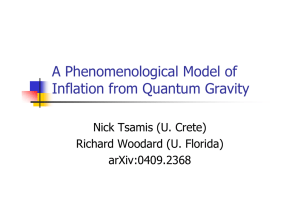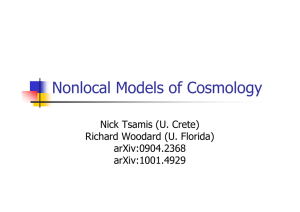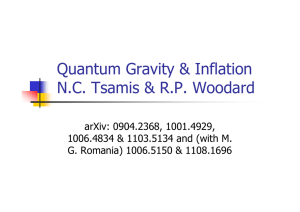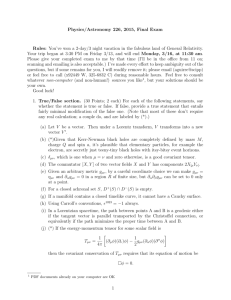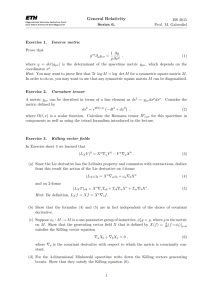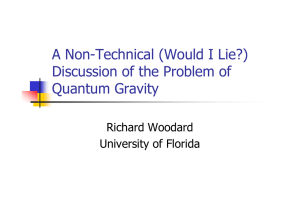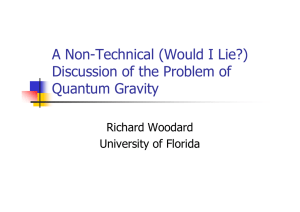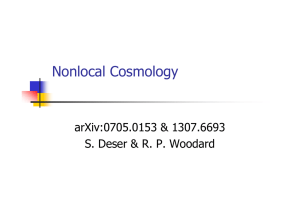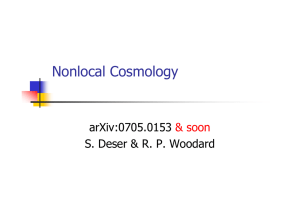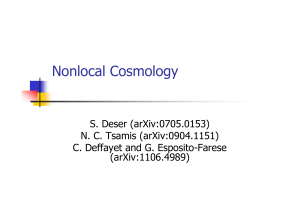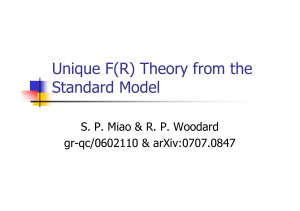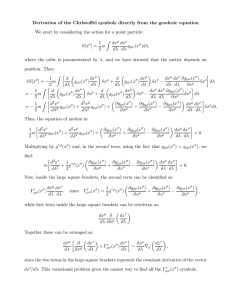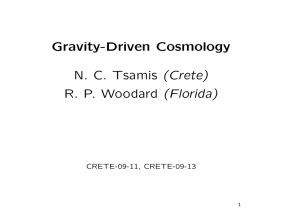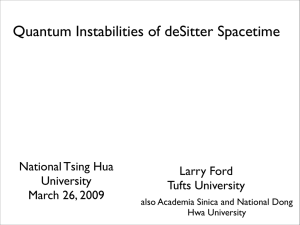Back-Reaction, Relaxation of Λ & Dark Energy Richard Woodard (U. Florida)
advertisement
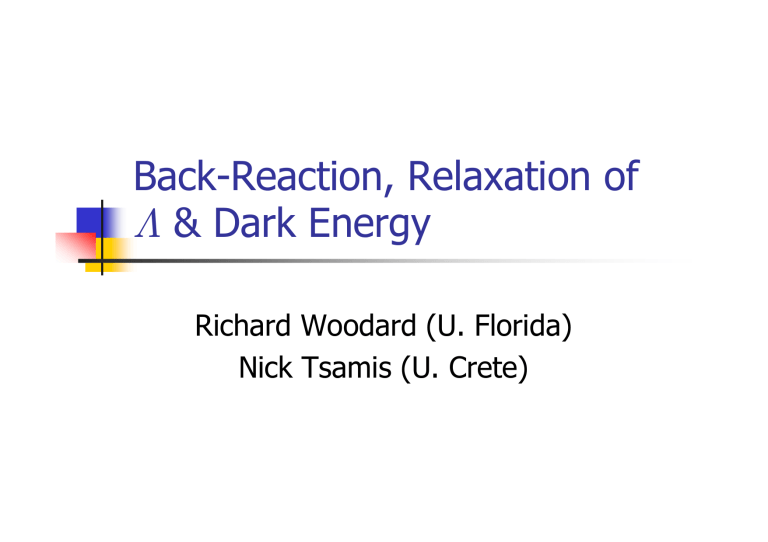
Back-Reaction, Relaxation of Λ & Dark Energy Richard Woodard (U. Florida) Nick Tsamis (U. Crete) Quant. Gravitational Inflation Fund. IR gravity: Gµν = -Λgµν Λ ∼ [1012 GeV]2 starts inflation QG “friction” stops inflation ds2 = -dt2 + a2(t) dx2 with a(t) = eHt ρ ∼ +Λ2 ρ ∼ –GΛ3 ln[a(t)] ρL ∼ – Λ2 [GΛln(a)]L Hence p ∼ -ρ ∼ Λ2 f[GΛln(a)] Only Causality Stops Collapse! IR gravitons ρ ∼ +Λ2 w/o causality ρ ∼ –GΛ3 a2(t) R(t) ∼ a(t)/H and M(t) ∼ H a3(t) ∆E(t) = -GM2/R ∼ –GΛ3 a5(t) Causality changes powers of a(t) to powers of ln[a(t)] But grav. Int. E. still grows w/o bound Need Phenomenological Model Advantages of QG Inflation Natural initial conditions No fine tuning Unique predictions But tough to USE! Try guessing most cosmologically significant part of effective field eqns Gµν = -Λgµν + 8πGTµν[g] Tµν[g] = p gµν + (ρ+p) uµuν Posit p[g] Infer ρ and uµ from conservation Getting p[de Sitter] = Λ2 f[GΛ ln(a)] […] must be nonlocal because Rµνρσ = Λ/3 [gµρ gνσ – gµσ gνρ] Simplest is X = 1/ R R & R = 6 dH/dt + 12 H2 for flat FRW f(t) = -a-3 d/dt [a3 df/dt] Hence 1/ f = -∫t du a-3 ∫u dv a3 f(v) For de Sitter a(t) = eHt and dH/dt = 0 ≡ (-g)-½∂µ[(-g)½gµν∂ν] 1/ R = - 4 Ht + 4/3 [1 – e-3Ht] ∼ -4 ln(a) Also DP = 2 + 2 Dµ[Rµν – gµν R/3]Dν On f(t) a-3 d/dt a d/dt a d/dt a d/dt Hence 1/DP [αR2 + β R] also possible Spatially Homogeneous Case Gµν = (p-Λ)gµν + (ρ+p) uµuν Two Eqns X =1/ R = -∫tdu a-3∫udv a3 [12H2 + 6dH/dv] p = Λ2 f(-GΛ X) ρ+p = a-3∫tdu a3 dp/du and uµ = δµ 3H2 = Λ + 8πG ρ -2dH/dt – 3H2 = -Λ + 8πG p (easier) Parameters 1 Number: GΛ (nominally ∼ 10-12) 1 Function: f(x) (needs to grow w/o bound) Numerical Results for GΛ=1/300 and f(x) = ex-1 X= -∫tdu a-3∫udv a3R Criticality p = Λ2f(-GΛX) = Λ/8πG Evolution of X(t) Falls steadily to Xc Then oscillates with constant period and decreasing amplitude For all f(x) growing w/o bound Inflation Ends, H(t) goes < 0, R(t) oscillates about 0 Analytic Treatment (ǫ ≡ GΛ) 2 dH/dt + 3 H2 = Λ[1 - 8πǫf(-ǫX)] X(t) = Xc + ∆X(t) Use R = 6 dH/dt + 12 H2 f ≈ fc - ǫ∆X f’c 2dH/dt + 3 H2 ≈ 24πǫ f’c ∆X L.H.S. = R/3 – H2 ∆X = 1/ R – Xc Act = -[d/dt + 3H]d/dt to localize [(d/dt)2 + 2H(d/dt) + ω]R ≈ 0 R(t) ≈ sin(ω t)/a(t) ω = 72πǫ f’c (agrees with plots!) Origin of Scalar Perturbations In Fundamental QG Inflation 1. L = 1/16πG (R - 2Λ)(-g)½ Two hij’s can make a scalar! E.g. Graviton KE: ḣij ḣij + ∇hij ∇hij Usually negligible but if IR logs make homogeneous ~ O(1) maybe perts ~ O(GΛ) In Phenomenological Model 2. Tµν[g] = p gµν + (ρ+p) uµuν p = Λ2 f(-GΛ/ R) fixed by retarded BC But ρ and ui at t=0 not fixed by DµTµν = 0 Analysis (in conformal coords) 0th order: 2a’’/a3 - a’2/a4 = Λ[1 – 8πǫf(-ǫX0)] hµνdxµdxν = -2φdη – 2B,idxidη – 2[ψδij + E,ij]dxidxj Φ = φ – a’/a (B-E’) – (B’-E’’) Ψ = ψ + a’/a (B-E’) Gij Eqn Ψ = Φ and 2/a2 Φ’’ + 6a’/a3 Φ’ + [4a’’/a3 - 2a’2/a4] Φ = -8πǫΛ f’(-ǫX0) × 1/ 0 [∇2/a2 Φ - 6/a2 Φ’’ - 24 a’/a3 Φ’ - 4/a2 X0’ Φ’] Divide by f’(-ǫX0) & act 0 = a-2[∂02 + 2a’/a ∂0 - ∇2] 4th order eqn 2 physical & 2 unphys. If X0(t) Xc then Φ(t,x) const Late Time Acceleration Model driven by X = 1/ R QG ends inflation, reheats & then turns off for most of cosmological history X(t) = -∫tdu a-3∫udv a3 R Xc H = 2/3t R = 4/3t2 ≠ 0 Oscillations & H < 0 efficient reheating H = 1/2t R = 6 dH/dt + 12 H2 = 0 X(t) ≈ Xc – 4/3 ln(t/teq) But this gives FURTHER screening! X2 = -1/DP [αR2 + β R] α > 0 ends inflation β > 2/3 α late acceleration Conclusions Advantages of QG Inflation 1. 2. 3. 4. Based on fundamental IR theory GR Λ not unreasonably small! Λ starts inflation naturally QG back-reaction stops Simple idea: Grav. Int. E. grows faster than V 5. 1 free parameter: Λ But tough to use Phenom. Model Tµν[g] = p gµν + (ρ+p) uµuν Guess p[g] = Λ2 f(-GΛ X) Homogeneous evolution: (generic f) X falls to make p cancel –Λ/8πG Then osc. with const. period & decr. amp. Reheats to radiation dom. (R=0) X1 = 1/ R or X2 = -1/DP [αR2 + β R] Infer ρ and ui from conservation Matter dom. R≠0 X2 can give acceleration Perturbations look good
